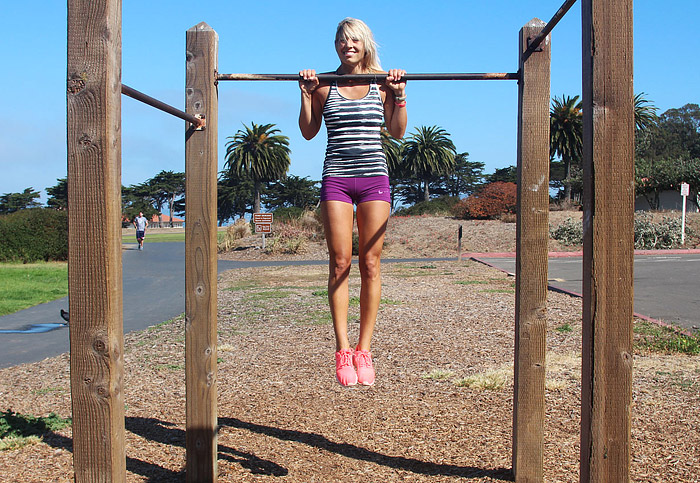
Love ’em or hate ’em, pull-ups are one of the best ways to build strength, muscle and shape in your back. Whether we’re afraid we’ll fail or are simply not strong enough to rep it out, most of us avoid that high bar like the plague. But you can do pull-ups. All it takes is a little practice and a lot of determination, and you’ll be looking down on the world from above that bar before you know it.
Here’s the thing: In order to do pull-ups well, you have to actually practice doing them. Yes, supplemental exercises that involve the same muscles can help build strength, but biomechanically, pull-ups are a unique kind of movement. With that in mind, here are some tips for divas of all levels to improve and eventually master this master of all moves.
BEGINNERS (0-6 MONTHS TRAINING EXPERIENCE)
Machines: Machines offset some of your bodyweight with plates, allowing you to do a pull-up while using correct form. Use enough weight so you can perform eight to 10 pull-ups with good form. As you improve, decrease the amount of weight you use as ballast to increase the challenge.
Heavy pull-up bands: These large rubber bands also work by offsetting your weight and come in varying thicknesses, with the thickest ones assisting the most. To use a band, simply loop it around a pull-up bar and stand on a plyo box behind it. Place one foot into the loop of the band and grasp the bar overhead. Step off the box and the band will offset some of your weight so you’re able to do a pull-up.
Supplemental exercises: one-arm bent-over dumbbell rows, wide-grip pull-downs
INTERMEDIATE (6-12 MONTHS TRAINING EXPERIENCE)
Negatives: Your muscles are stronger on the eccentric (negative) portion of a repetition, so practicing this technique can make your positive (concentric) contraction easier. Place a plyo box underneath a pull-up bar and take an overhand grip on the bar. Jump up and hold the top of a pull-up for one count, then lower to the start as slowly as possible. Every other week, do three sets of six to eight negatives to prevent burnout.
Medium pull-up bands: Once you’ve graduated from the heavy bands, try the next-thinnest band. Avoid “kipping” or swinging to get yourself up over the bar.
Supplemental exercises: back extensions, bent-over barbell rows
ADVANCED (12-24 MONTHS TRAINING EXPERIENCE)
Hand position: Wide-grip pull-ups are arguably the hardest kind to master, but there are many variations that can improve your wide-grip skill and stamina. Start your workout with a few sets of wide grips, then try using a narrow underhand grip — which engages the biceps as well as the midback muscles — or a shoulder-width grip to engage the lats, shoulders, midback and traps.

Light pull-up bands: These will be the most tempting band with which to “cheat,” but stay strict with your form — you’re almost band-free!
Supplemental exercises: deadlifts
PERFECT FORM: WIDE-GRIP PULL-UP
1) Stand on a box and take a wider-than-shoulder-width overhand grip on the bar.
2) Step off the box and hang straight down from the bar.
3) Bend your knees, crossing your feet behind you.
4) Look up toward the bar and lift your chest.
5) Drive your elbows down and back and pull your chest up toward the bar as high as you can.
6) Squeeze your shoulder blades together and pause a moment at the top, then slowly lower back to the start under control.
FOR ALL LEVELS
• Warm up thoroughly using dynamic stretches that target your back and core.
•Do pull-ups first in your routine when you have the most energy.
• Shoot for three sets of as many reps as you can do using proper form. (Practicing sloppy pull-ups will only train you to be a sloppy puller-upper.)
• Keep a weekly log of your rep count so you can track your progress.
Please follow us on Pinterest and enjoy our collection of recipes, crafts, fitness, health tips, gardening, DIY and more…





this is one the best exercise and here we don’t need any weights……just pulling your body weight against the gravity….initially it is tough to get 2 or 3 pull ups but once your muscles are flexed you can easily take out sets of 10….pull ups helps you get your back in shape, build biceps and makes your shoulder strong.